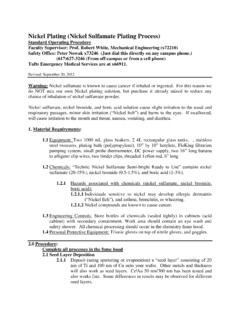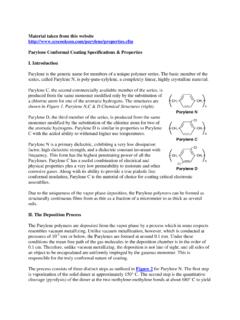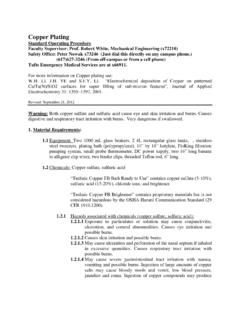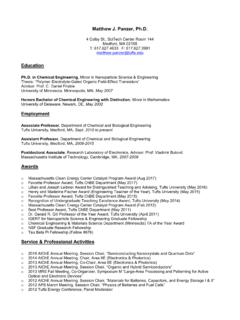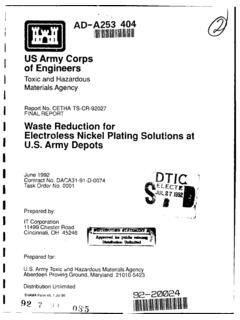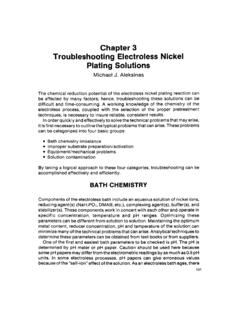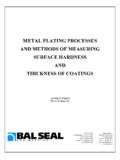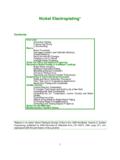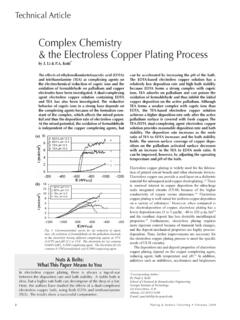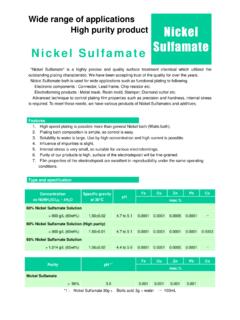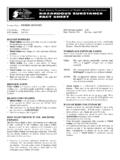Transcription of Electroless Nickel Plating - School of Engineering
1 Electroless Nickel Plating Standard Operating Procedure Faculty Supervisor: Prof. Robert White, Mechanical Engineering (x72210) Safety Office: Peter Nowak x73246 (Just dial this directly on any campus phone.) (617)627-3246 (From off-campus or from a cell phone) Tufts Emergency Medical Services are at x66911. Revised: February 19, 2016 Goal: Deposit a layer of Nickel alloy on a wafer using Electroless (autocatalytic) Nickel Plating . The MCT-14 activator is intended for Plating on a copper surface. Plating on other surfaces may be possible as well. The user will have to experiment. The Plating can be masked with hardbaked AZ9260 photoresist for some time, although for long Plating times degradation may occur.
2 Warning: Nimuden NPR-18CM (Uyemura Corp) contains Nickel and ammonium salts and is acidic. Nickel may cause an allergic dermatitis. Nickel containing salts may be harmful to nasal cavities and lungs. Nickel compounds are known carcinogens. The NPR-18CM should be considered toxic and corrosive. Uyemura MCT-14 contains approximately 10% sulfuric acid. It will burn the skin and eyes. The MCT-14 should be considered corrosive. Material Requirements: Equipment and tools: Four glass petri dishes, magnetic stirrer with hotplate, stir bar, stainless steel tweezers, thermometer Chemicals: Nimuden NPR-18CM (contains Nickel and ammonium salts) Individuals sensitive to Nickel may develop allergic dermatitis ( Nickel Itch ), and asthma, bronchitis, or wheezing.
3 Nickel compounds are known to cause cancer. Nickel compounds can be toxic. Uyemura MCT-14 (10% sulfuric acid) Will cause skin and eye burns and respiratory tract irritation. Engineering Controls: Store bottles of chemicals (sealed tightly) in cabinets (acid cabinet). Conduct procedures in the fume hood. Dispose of chemicals as described at the end of this document. Personal Protective Equipment: Nitrile gloves and eye protection required for all procedures. When working in the fume hood, also wear trionic gloves, apron, and chemical goggles. Procedure: Complete all processes in the fume hood Prepare the NPR-18CM Plating solution Place the glass petri dish labeled uyemura Electroless Nickel on the magnetic stirrer Fill the petri dish about halfway with the NPR-18CM Plating solution Place magnetic stirrer in petri dish and set the rotation speed to 125 RPM.
4 Heat the solution Recommended solution temperature: 80 C. Set the hotplate front temperature to 115 C and wait 10 minutes for temperature to stabilize. Adjust the hotplate if necessary to achieve 80 C solution temperature. The petri dish must remain covered during this step Nickel Plating Perform these steps in the Chemistry Fume Hood Fill two rinse glass petri dishes with deionized water about halfway. Fill the glass petri dish labeled MCT-14/activator about halfway with the MCT-14 solution. Transfer the sample carefully to the MCT-14/activator petri dish Recommended time in solution: 2 minutes Slight agitation by carefully moving the petri dish manually is recommended as well Transfer the sample carefully to the uyemura Electroless Nickel (NPR-18CM) petri dish Immediately cover the petri dish Expected Plating rate: 300nm/min.
5 Start your timer! After the Plating time is complete, turn off the hotplate DI Water rinse Perform these steps in the Chemistry Fume Hood Transfer the sample carefully to the first DI water rinse petri dish. If you used tweezers to move the sample, make sure you rinse them as well. Let the sample and tweezers soak in DI water for 3 minutes. Transfer the sample to the second DI rinse petri dish, and rinse for another 3 minutes. Sample dry: After the water rinse is finished, remove your sample blow dry it with the air gun. Inspect wafer for the thickness of the Nickel . If more Plating time is required, place wafer back into the Plating petri dish with the solution.
6 Repeat Plating , rinse and drying procedure. Clean-up: Dump the Plating solution, activator solution, and both rinse waters into the Plating waste bottle (HDPE bottle). The solution can be mixed with Nickel sulfamate and copper sulfate (acid copper) Plating solutions containing sulfuric acid and boric acid. Rinse all petri dishes twice more with DI water, and dump them into the Plating waste bottle. If possible, remove Nickel flakes that may be stuck to uyemura Electroless Nickel petri dish while rinsing. Return all labware to its proper location. Turn off the hotplate and unplug it. Clean off any residue from the hotplate or surfaces with cleanroom wipes.
7 Dispose of solid in acid trash. Remove the hotplate from the hood. Storage: Store MCT-14 and NPR-18CM in the acid cabinet. Waste Disposal: Electroless Nickel Plating waste: Solid waste should go in the acid/base waste bin. Liquid waste should go in the Plating waste container (HDPE bottle). Can mix with sulfuric acid, boric acid, Nickel sulfamate, copper sulfate Accident Procedures: Contact: Read SDS prior to working with any chemical to familiarize yourself with the symptoms of exposure and recommendations for treatment. Inhalation: If you breathe these fumes, you may feel dizzy. If this occurs, turn off the hotplates and leave everything in the hood.
8 Leave the room and get some fresh air. If symptoms persist, contact Tufts health services and inform the lab directory and Tufts health and safety office. Call Tufts Emergency Medical Service at x66911. Skin contact: For minor contact, exit the lab and rinse the affected area with water. For major contact get in the safety shower and remove the affected clothing. Have someone call emergency health services. Call Tufts Emergency Medical Service at x66911. Eye contact: Immediately flush with water for at least 15 minutes at eye wash station while lifting upper and lower eyelids occasionally. Get immediate medical attention. Call Tufts Emergency Medical Service at x66911.
9 Spill: If a small, contained spill occurs, such as inside the hood, wipe it up with chemical wipes and dispose of in the solvent trash container. If a large spill occurs that you are not comfortable cleaning up, such as breaking a bottle on the floor, evacuate the lab and contact Tufts emergency services (x66911). Fire: Do not put the mixed solution on or near the hotplates when they are turned on. If a fire starts, remove any solvents from near the fire if it is safe to do so, and exit the lab. Do not try to fight the fire. Immediately contact Tufts emergency services once you are outside the lab at Tufts Emergency Services at x66911.
10 If at any time you feel a situation is dangerous, do not hesitate to call the safety office (x73246, Peter Nowak) or the faculty supervisor (x72210, Robert White). Please inform of the faculty supervisor and/or the health and safety office of any accident or health concern. Report all accidents (injuries, major spills, fires) to the safety office at x73246 (Peter Nowak) and the faculty supervisor at x72210 (Robert White). For emergencies, call Tufts Emergency Services at x66911.
